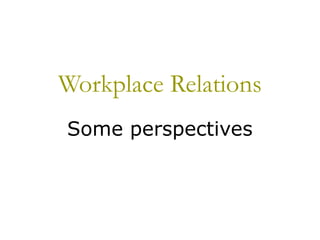
Workplace relations perspectives
- 2. INTRODUCTION Continuing high levels of unemployment, massive foreign debt, declining relative standards of living and ever-increasing competition are creating pressures for more workplace relations reform. Higher productivity translates into higher wages, better jobs and improved job security. All parties agree reform is inevitable. The problem is obtaining consensus about the type and degree of change necessary. The way people view the challenges of reform is in large part influenced by their perspective on workplace relations.
- 3. APPROACHES TO WORKPLACE RELATIONS Some perceive workplace relations in terms of class conflict, others in terms of mutual cooperation and others still in terms of groups with competing interests. Human resource managers need to understand these varying approaches because they provide the ideological underpinning for much of the debate about workplace reform and the role of HRM.
- 4. UNITARY APPROACH Workplace conflict is seen as a temporary aberration, resulting from poor management, employees who do not fit with the organisation’s culture or trade union activity. Trade unions are regarded as competitors for the employee’s commitment and cooperation. The underlying assumption is that it is to the benefit of all to focus on common interests and promote harmony. Conflict in the form of strikes, therefore, is regarded as not only unnecessary, but destructive. Advocates of the unitary approach seek a radical overhaul of the industrial relations system. Emphasis is on direct negotiations with employees.
- 5. PLURALIST APPROACH In contrast to the unitary approach, the pluralist approach sees: organisations as coalitions of competing interests, where management’s role is to mediate among the different interest groups trade unions as legitimate representatives of employee interests stability in workplace relations as the product of concessions and compromises between management and unions.
- 6. MARXIST APPROACH Marxists, like the pluralists, regard conflict between management and employees as inevitable. However, where pluralists see conflict inherent in all organisations, Marxists see if as a product of a capitalist society. Adversarial relations in the workplace are simply one aspect of class conflict. The Marxist approach thus focuses on the type of society in which an organisation exists. For the Marxist, therefore, all strikes are political.
- 7. TRADE UNIONS The old system of compulsory arbitration encouraged trade unionism. Union concerns have traditionally focused on pay rates, conditions of work and job security. Increasingly, however, unions are moving away from these bread and butter issues and adopting an approach of strategic unionism that includes industrial democracy, social welfare, training, industrial policy and taxation. Moreover, because most awards, determinations and industrial agreements set only minimum rates and conditions, unions also seek to negotiate above-award concessions from employers. Some unions see enterprise bargaining as being limited to just that.
- 8. Reasons Why Employees Join Unions Compulsion Protection Social pressure Political beliefs Solidarity Tradition Pay and conditions Communication Health and safety
- 9. Grievances, Disputes and Industrial Relations Processes The employee approaches his/her immediate supervisor to discuss the grievance. If the grievance remains unresolved, the employee next approaches the shop steward who then approaches the supervisor. If the matter still remains unresolved, the shop steward contacts a union organiser who negotiates with the HR manager and/or a line manager and/or an employer association representative. If the matter is still unresolved, it may be referred to the IRC for conciliation.
- 10. Workplace-Level Grievances Grievances are the product of employee dissatisfaction or feelings of injustice. Listen carefully to what the employee says and try to distinguish between facts and feelings. Managers should be sure that they have all of the relevant facts. Avoid lengthy delays. Managers should also recognise that sometimes a union is placed in the awkward position of having to argue a case it does not genuinely support. The successful handling of grievances is related to the attitudes of the parties involved.
- 11. Tribunal-Level Grievances When a grievance cannot be resolved at the workplace level, a HR manager may need to present his or her organisation’s case before an industrial tribunal such as the IRC. HR managers must develop the skills and confidence to take (and be given) the responsibility for advocacy. Who else has (or should have) as much knowledge about past disputes, custom and practice, personalities, pay rates and conditions as an organisation’s HR manager?
- 12. Some Common Features of Enterprise Bargaining Agreements Emphasis on developing a workplace culture that encourages enhanced productivity and efficiency Promotion of mutual discussion between employers and employees in a conflict-free environment A focus on customer satisfaction with an emphasis on product and service quality as a means of becoming more competitive An emphasis on the need to implement workplace change to ensure the survival of the enterprise by becoming internationally competitive
- 13. SUMMARY The changing nature of global markets and the need to become more customer driven have forced a critical re-examination of the way workplace relations is handled. Radical, pluralist and unitary approaches (in one form or another) all have their supporters.
